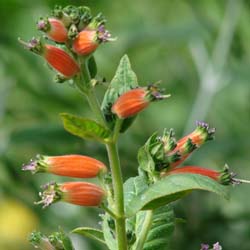Bat-Faced Beauty: Gardeners & Hummingbirds Love Cuphea schumannii

Most bat faces only look beautiful to their mothers. However bat-faced Cuphea schumannii seems pretty as punch to hummingbirds in search of a sweet drink of nectar.
Aside from being known as Schumann's Cuphea, this hummingbird favorite is called Orange Cigar Plant due to the shape of its tubular flowers. But if you take a close look at the ragged, open end of each flower, you'll see two, tiny, lavender petals standing straight up like bat or mouse ears. So, despite its common name, C. schumannii is what is known as a bat-faced Cuphea. True "cigar" Cupheas don't have petals.
Blur your vision when you look at a C. schumannii flower, and you may imagine that the stamens poking out of the cigar form the snout of a bat or the whiskers of a mouse.
Magnet for Pollinators
Aside from attracting hummingbirds, Orange Cigar Plant is a favorite of butterflies and honeybees. It's one of many Cupheas grown by FBTS for beauty as well as backyard buzz. By attracting pollinators, Cupheas increase garden productivity. But similar to the Salvia genus, Cupheas don't attract deer.
C. schumannii is a useful plant not only for wildlife gardens but also for naturalistic landscapes in which its sprawling branches can create a relaxed look.
The glossy, light green foliage has egg-shaped leaves with pointed tips and margins fringed with tiny hairs. However, during flowering season Orange Cigar Plant is so floriferous that you may be more focused on the blossoms than the handsome greenery.
Native Plant of Mexico
Orange Cigar Plant is one of about 260 species in the Cuphea genus. Native to the warm winters of the Mexican states of Oaxaca and Veracruz, it is a perennial in USDA plant hardiness zones 8 to 9.
All together, Cupheas are heat-tolerant plants that are mainly native to the Caribbean, Central America and South America. Botanic researchers theorize that the genus originated in South America. But Cupheas are part of the wide-ranging Loosestrife family (Lythraceae), which stretches from Europe to Hawaii.
Depending on the species, Cupheas range from marsh plants to mesophytes (plants preferring conditions that aren't extremely wet or dry). Orange Cigar Plant is a mesophyte and appreciates supplemental watering if local rainfall is insufficient to maintain cool, slightly moist soil. In damper climates, such as in Florida, it can withstand drought once established.
A Bit of Botanical History
Irish physician and botanist Patrick Browne (1720-1790) was the first naturalist to collect Cuphea specimens. He found them in Jamaica and described them in his 1756 book Civil and Natural History of Jamaica. However, Cupheas didn't become popular horticultural species until recent decades.
It's unknown who first collected C. schumannii for horticultural study. However, German botanist Bernhard Adalbert Emil Koehne (1848 - 1914), who specialized in the Lythraceae family, analyzed the plant in 1900. Koehne named it after another German botanist, Karl Moritz Schumann (1851 - 1904), who was curator of the Berlin Botanical Museum from 1880 to 1892.
Schumann was also fascinated by plants of the Western Hemisphere and is well known for expanding knowledge about the cactus family (Cactaceae).
It's difficult to propagate Orange Cigar Plant except in summer, which may be one reason why the species is available from only a few nurseries, such as Flowers by the Sea. Yet it is a particularly rewarding plant for wildlife gardens.
Cupheas are also becoming valuable oilseed crop plants.
Sources of Fatty Acids
Instead of cooking oil, Cupheas produce oils used in manufacturing. They are high in lauric and capric acid, which are fatty acids that aid in making personal care products, fragrances, detergents and industrial lubricants. C. schumannii is particularly high in capric acid.
According to Biomass Magazine, the oil from Cuphea seed may someday replace imported coconut, palm and petroleum oils.
Crop Rotation Tool
It's fascinating to ponder the fact that the abundantly flowering bushes attracting hummingbirds to backyards also may benefit farmers and improve agricultural practice.
Farm Industry News in 2006 reported agricultural research showing that in addition to becoming a promising oilseed crop, Cupheas also reduce the need for pesticides and herbicides when grown in rotation with grain crops, such as corn. The magazine noted that rotation with Cupheas reduces rootworm infestation.
Batty Cigars in the Vegetable Garden?
If you regularly grow corn in a large vegetable garden, it may be a good idea to experiment with rotating it with patches of bat-faced Orange Cigar Plant or other cute Cupheas. Just grow them as annuals. You'll feed more than your family.
For more information about Orange Cigar Plant and any of the Cupheas grown at Flowers by the Sea, please contact us. We want to spread the word about this pretty and practical genus.

Comments
There are no comments yet.